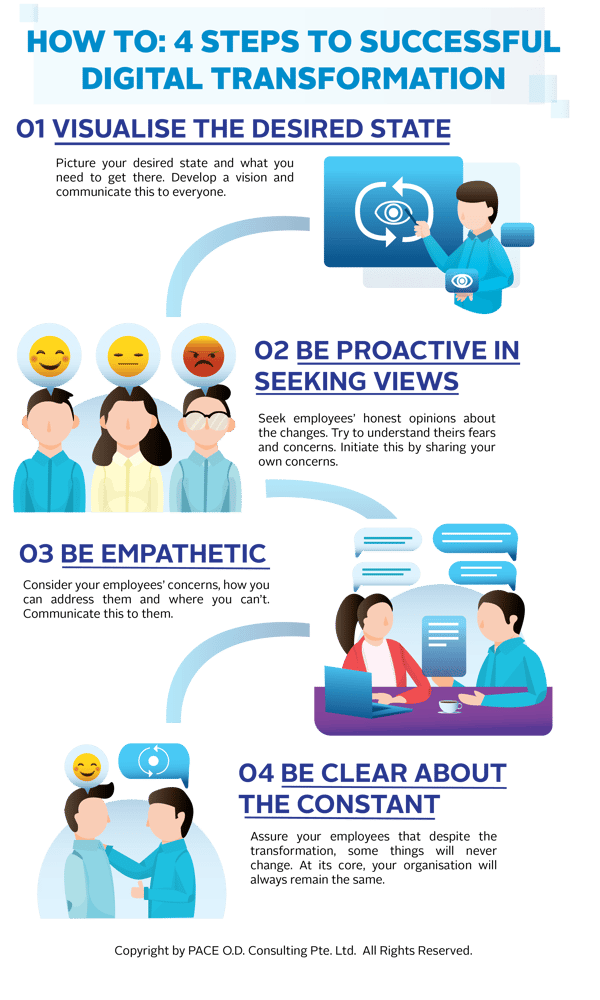It's no secret we're in the age of digital transformation.
The world is changing at a rapid pace. Emerging technology tools such as blockchain, artificial intelligence and predictive analytics have drastically changed the way we work today. These digital tools have even disrupted long-standing business models and operating structures, creating new organisations and industries in its wake. And with the rapid evolution of technology, the potential for change just continues to grow.
If you’re reading this article, you probably understand the need to transform your organisation to keep up with the pace of digitalisation and change. Digital transformation often entails the incorporation of new technological tools and with it, the structure of an organisation, and how technology can be embraced seamlessly for greater efficiency.
In our experience, this can be a disruptive and drastic change. Developing digital solutions and incorporating them into an organisation is often just the first step. Changing the culture and getting employees to embrace the change, however, is often the hardest part.
See also: Staying Inclusive Amid Tech Changes in Singapore
Here’s our tip - focus on your employees.
Employees are the heart of your organisation, and they are the ones who will help drive the organisation forward. For digital change and transformation to work, it is crucial that employees buy into and embody your vision.
This is however easier said than done. There’s no denying that digitalisation can be an uncomfortable and foreign process, especially for senior employees. These employees could be used to traditional and familiar ways of doing things, and this change could create a sense of loss and frustration for them. Not handling these feelings well could lead to denial and even anger at the leaders who initiated the change. They could then make these leaders the problem instead, making digital change counter-productive.
As a leader, managing this reaction to change is crucial to help you realise your vision of a digital enterprise.
See also: 4 Things to Avoid in Change Management
However, these steps may be easier said than done, especially in a large organisation with many layers and departments. Here are four simple steps to help you:
1) Visualise your desired state and the perceived gap
Think about your organisation today, and how you want it to be shaped by technology. Is it to drive data analytics and harness artificial intelligence? Or perhaps it’s to adopt new systems that can cut short existing processes and enhance productivity. Think then about what is lacking, and how you can get there. Use this to picture a compelling vision to help others see these exciting prospects, and communicate it to everyone.
2) Be proactive and seek out feelings and views from all levels of the organisation
Draw out employees from all levels of the organisation and seek their honest opinion of the proposed change. Depending on your organisation, this may be in the form of personal engagement sessions or even blind polling. You can also initiate this by being open and sharing your own emotional reaction. Share your excitement and even your personal fears about the change, and how you intend to handle it. This will make you more relatable to your employees and show them they’re not alone.
3) Empathise with your employees and show you care
Empathy goes a long way. Consider the feedback you obtained, how you can address some of your employees’ issues, and where you can’t. Communicate this (both how you can address their issues and where you can’t) to your employees. Showing you’re listening to them will make your employees more open to accepting your vision and feel that you’re on your side. Watch our video on effecting change to see how you can do that!
4) Be clear about the constant - your organisation’s culture
As humans, we’re all afraid of the unknown. This is where the fear of change stems from, and it is actually a very normal reaction. To overcome this, assure your employees that some things will never change. This is the core of your organisation - the glue that holds everything together. This is what will assure your employees that despite these changes, the heart of the organisation remains the same. This may in fact be an opportunity to strengthen your organisation’s change culture, and put everyone on the same page in the face of change.
 Technology may be daunting, but it is important as an organisation to embrace this and adapt to the continuous changes in the business landscape. This could go a long way in keeping you organisation up to date and improve internal processes. While uncomfortable, change also provides an opportunity to reshape your organisation's culture and strengthen it, to move it forward.
Technology may be daunting, but it is important as an organisation to embrace this and adapt to the continuous changes in the business landscape. This could go a long way in keeping you organisation up to date and improve internal processes. While uncomfortable, change also provides an opportunity to reshape your organisation's culture and strengthen it, to move it forward.


